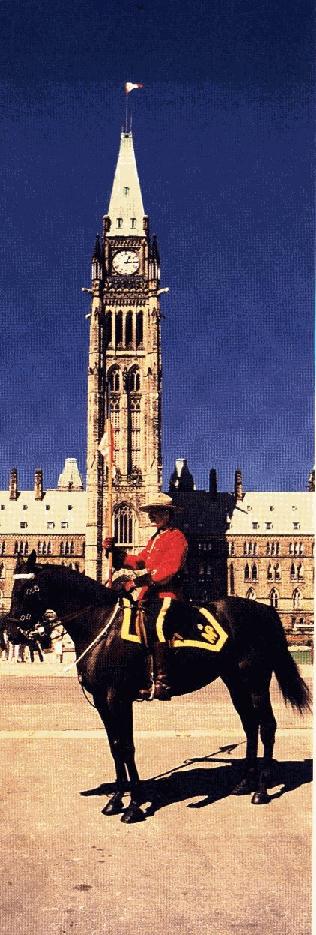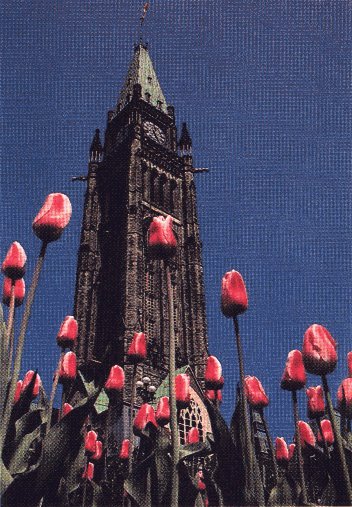



INTRODUCTION

NAME: Canada
GEOGRAPHICAL SITUATION: North America
CAPITAL: Ottawa
MAIN CITIES: Toronto, Montreal, Vancouver, Ottawa and Quebec
AREA: 9 975 000 Km2 - the second largest country in the world
POPULATION: 28 100 000 inhabitants (Canadians)
NATIVE PEOPLES: Amerindian tribes and Inuits (Eskimos)
OFFICIAL LANGUAGES: English and French
RELIGIONS: Catholicism and Protestantism
CURRENCY: Canadian dollar ($)
METHOD OF GOVERMENT: Parliamentary
TYPE OF STATE: Federal State (Ontario, Quebec, Nova Scotia, New Brunswick, Manitoba, British Colombia, Prince Edward Island, Saskatchewan, Alberta and Newfoundland)
HEAD OF STATE: Governor General representing the British Crown
LEGISLATIVE ORGAN: Parliament constituted by a House of Commons and a Senate.
NATIONAL SYMBOLS: the acer leaf (even in the flag);
the Royal Canadian Mounted Police;
the Peace Tower of Parliament
PLACES OF INTEREST: the Niagara Falls;
the Great Lakes;
the 1000 Islands (in St. Lawrence River);
the circumpolar regions (with the Eskimos);
the large towns
GEOGRAPHY and POPULATION
Canada is surrounded by three oceans: the Atlantic, the Pacific and the Arctic.
Its population is small and scattered. 90% of the Canadians live in the southern zone, a few miles north of the frontier with the United States, 75% of it in cities and large urban centres. Here the climate and the landscapes are more inviting, specially in St. Lawrence Valley and near the lakes Huron and Ontario.
The country is rich in natural resources and surprisingly beautiful landscapes. Its gigantic area gives it a natural diversity: the western Rocky Mountains, hills, plains, forests, countless lakes and tundra.
In Canada there are still about 570 000 Amerindians and 33 000 Eskimos and many immigrants from all over the world. But the first settlers were French and English and today 27% of Canada’s citizens are of French origin ( mainly in Quebec) and 40% of the population is of British descent, specially come from the USA. That’s why that are two official languages: English and French.

A cruise
 |
 |
| An Eskimo | Niagara Falls |
THE BIG TOWNS
MONTREAL
Montreal is situated on the Quebec region, on the St. Lawrence River banks.
It’s one of the largest cities in Canada. It is an important port linking the Great Lakes to the Ocean by the Seaway or St. Lawrence canal.
Its avenues have 10 to 20 Km long.
 |
 |
| Montreal - an avenue | Montreal - panoramic view |
TORONTO
It is the Ontario’s capital and the Canada’s largest city, with a population of over 3,4 million.
Toronto’s flying-saucer-shaped City Hall, Nathan Phillips Square and the CN Tower are some of Canada’s most famous buildings.
 |
 |
| Toronto’s towers seen from Lake Ontario | View from another point |
OTTAWA
It’s the capital of Canada and it is situated on the eastern edge of the province of Ontario.
Although it has less than one million inhabitants, it is a charming city with a dozen museums and art galleries, including the spectacular new National Gallery that houses Canada’s national treasures. The imposing Parliament buildings, seat of Canada’s government, sit high above the Ottawa River. Historic sites, the pomp and ceremony of state visits, the changing of the guard, the tulip festival and a vibrate multicultural scene make Ottawa a delightful and fascinating city.
 |
 |
 |
| National Gallery | Parlament buildings | |
_________________________
QUEBEC
It’s the capital of the province of Quebec and it’s situated on St. Lawrence River, in the point it joins St. Charles River.
It also has less than one million inhabitants, but it is an important port and a commercial and industrial centre.

VANCOUVER
It’s the largest Canadian city on the Pacific Coast, in the province of British Columbia.
It’s near a large and deep bay that provides an excellent port.

THE END
Rui Nuno Leitão de Carvalho